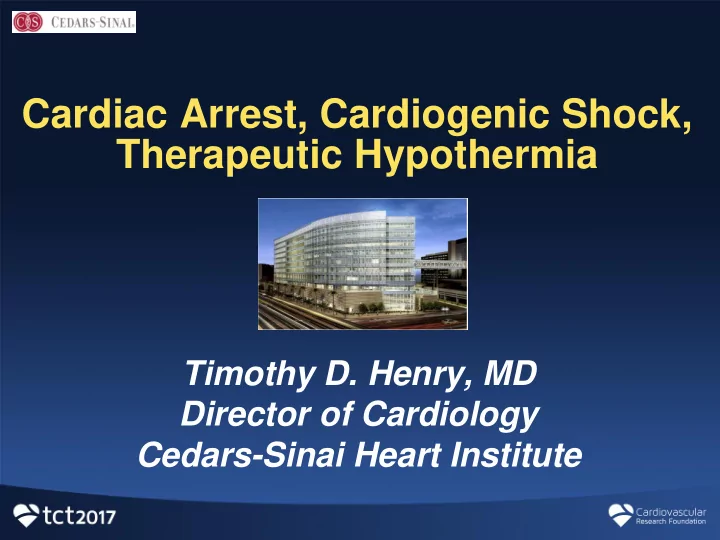

Cardiac Arrest, Cardiogenic Shock, Therapeutic Hypothermia Timothy D. Henry, MD Director of Cardiology Cedars-Sinai Heart Institute
Disclosures: ▪ Nothing to disclose
3 Out-of-Hospital Cardiac Arrest • 48 year old male presents to ER as an out of hospital cardiac arrest: witness report seizure like activity, then slumped in his chair. • EMS arrival: Somnolent, then arrested, Initial rhythm VF, multiple shocks, 4 epi and amio 300 in field. • Arrival to ER with ongoing CPR in PEA. • Risk factors, Previous History and Medications: None known
4 Out-of-Hospital Cardiac Arrest • Given age and initial rhythm, CT surgery called for VA- ECMO . Upon initiating ECMO , he was noted to have spontaneous respirations and blood pressure 140/90. • First EKG:
5 EKG#1 @ 12:20
6 48 year old with OHCA • Troponin #1 11:45 0.18 No ABG or lactate on arrival • Taken Emergently to Cath Lab • Timeline Arrival to ER: 11:39 AM EKG: 12:20 Door to ECMO Initiation: 30 minutes
7 Baseline Angiogram
LAD culprit PCI but what else? • Aspiration: yes or no? • Multivessel PCI (D Cx) yes or no? • ECMO: yes or no Impella? • Therapeutic Hypothermia: yes or no, what target, how long?
9 Cath Lab • Intervention Aspiration thrombectomy of the LAD. PCI to the proximal to mid LAD using a 3.5 x 38 Xience Alpine DES. PCI of the distal left circumflex using a 3.0 x 15 Xience Alpine DES. Placement of an Impella CP 4.0 • Peak Troponin: 46
10 Post PCI
11 EKG Post PCI
12 TTE: Hospital Day #1 Low normal LVEF 50 % with hypokinesis of the mid to apical septal wall otherwise normal
13 Hospital Course • Therapeutic Hypothermia. Initiated one hour after presentation via ECMO circuit, cooled to 33 degrees Rewarmed after 24 hours No focal neurologic deficits • MCS Impella removed Hospital Day #2 Decannulated Hospital Day #4 • Discharged Hospital Day #14 • 3 month follow up: Doing well, returned to work, playing soccer, on DAPT, no anginal complaints
Simple case?
Cardiac Arrest • Out-of-hospital cardiac arrest (OOHCA) • 295,000 people annually in the US • 7.9% median survival rate • Anoxic encephalopathy and neurologic deficits • Therapeutic hypothermia (TH) clinical trials • ILCOR recommendation for TH after resuscitation Lloyd-Jones D, Adams R, Carnethon M et al. Heart disease and stroke statistics-2009 update. Circulation 2009;119:e21-e181.
18 OHCA survival to hospital discharge by 5-year time periods Comilla Sasson et al. Circ Cardiovasc Qual Outcomes. 2010;3:63- 81
With hypothermia and PCI! Survival improves to 50- 60% with Favorable neurological outcomes in 86% of survivors Rab et al. JACC 2015;66:62-73
Early Transport to Cath Lab for ECMO and Revasc in Refractory VF (?OHCA)
Interaction of Cardiac Arrest and Cardiogenic Shock Cardiogenic Cardiogenic Shock Shock ( – ) (+) 184 Patients 317 Patients Cardiac In-hospital In-hospital Arrest (+) Mortality: 47.3% Mortality: 20.2% 1 – Year 1 – Year Mortality: 51.6% Mortality: 22.7% 259 Patients 4157 Patients Cardiac In-hospital In-hospital Arrest ( – ) Mortality: 25.1% Mortality: 1.7% 1 – Year 1 – Year Mortality: 33.6% Mortality: 5.5%
26 Survival related to outcome of PCI Florence Dumas et al. Circ Cardiovasc Interv. 2010;3:200-207
Early predictors of survival in OHCA Florence Dumas et al. Circ Cardiovasc Interv. 2010;3:200- 207
28 Early Transport to Cath Lab for ECMO and Revascularization in Refractory Ventricular Fibrillation • VF/VT Initial rhythm • DCCV x3 and 300mg Amiodarone without ROSC Out of • Time to CCL <30 min Hospital • ABG and lactate • Stop if: ETCO2<10mmHg, PaO2<50mmHg or Lactate >18 mmol/L • If ROSC, immediate Cor Angio +/- IABP. • If no ROSC, ECLS , then Cor Angio +/- IABP. Initial CCL • Continue ACLS/ECLS for 90 minutes/PCI; if no ROSC by 90 minutes, declared dead
29
30 Characteristics of Survivors
31 Complication Rate • 13% on ECMO had Vascular Complications • 4 with significant retroperitoneal bleeding requiring transfusion • 3 developed an ischemic leg after thrombosis of the distal perfusion cath
32 Comparison Between the Refractory VF/VT Protocol and the Historical Comparison Group
Cooling Outcomes Alive at hospital discharge with favourable neurological recovery Abbott Northwestern Hospital 53/96 55.2% • Survival by diagnosis – STEMI: 33/50 66.0% – Other: 20/46 43.5% • Survival by initial rhythm – VF/VT: 47/75 62.6% – PEA/Asystole: 5/19 26.3%
Transfer Outcomes Transfer = Blue line, ANW = Red line 1.0 0.9 0.8 Fraction surviving 0.7 0.6 0.5 0.4 0.3 0.2 0.1 0.0 2 3 4 5 7 20 40 60 300 500 1 10 100 1000 Days Arrest to Death or Last Know n Alive
Recommend
More recommend